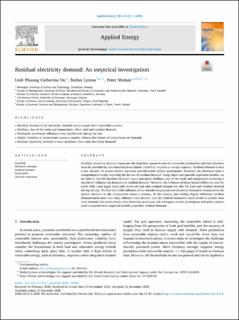| dc.contributor.author | Do, Linh Phuong Catherine | |
| dc.contributor.author | Lyócsa, Štefan | |
| dc.contributor.author | Molnar, Peter | |
| dc.date.accessioned | 2021-02-15T11:59:31Z | |
| dc.date.available | 2021-02-15T11:59:31Z | |
| dc.date.created | 2020-12-29T14:26:13Z | |
| dc.date.issued | 2020 | |
| dc.identifier.citation | Applied Energy. 2020, 1-18. | en_US |
| dc.identifier.issn | 0306-2619 | |
| dc.identifier.uri | https://hdl.handle.net/11250/2728076 | |
| dc.description.abstract | Residual electricity demand represents the load that cannot be met by renewable production and that therefore must be provided by conventional power plants, electricity imports or storage capacity. Residual demand is thus a key variable for power system operators and electricity market participants. However, the literature lacks a comprehensive study exploring the drivers of residual demand. Using linear and quantile regression models, we are able to identify previous demand, major and minor holidays, day of the week and temperature as having a significant influence on demand and residual demand. However, the influence of these factors differs not only for lower (left-) and upper (right-tail) levels of total and residual demand but also for total and residual demand during the day. We find that i) the influence of the outside temperature on electricity demand is weakened by the spatial variation in the temperature across a country, ii) the heating and cooling degree influences residual demand much more than they influence total demand, and iii) residual demand is much harder to predict than total demand. Our results imply, that electricity producers, risk managers, market participants and policy makers need comprehensive empirical models to predict residual demand. | en_US |
| dc.language.iso | eng | en_US |
| dc.publisher | Elsevier | en_US |
| dc.rights | Navngivelse 4.0 Internasjonal | * |
| dc.rights.uri | http://creativecommons.org/licenses/by/4.0/deed.no | * |
| dc.title | Residual electricity demand: An empirical investigation | en_US |
| dc.type | Peer reviewed | en_US |
| dc.type | Journal article | en_US |
| dc.description.version | publishedVersion | en_US |
| dc.source.pagenumber | 1-18 | en_US |
| dc.source.journal | Applied Energy | en_US |
| dc.identifier.doi | 10.1016/j.apenergy.2020.116298 | |
| dc.identifier.cristin | 1863823 | |
| dc.description.localcode | © 2020 The Author(s). Published by Elsevier Ltd. This is an open access article under the CC BY license (http://creativecommons.org/licenses/by/4.0/) | en_US |
| cristin.ispublished | true | |
| cristin.fulltext | original | |
| cristin.qualitycode | 1 | |

